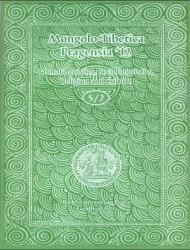Mongolo-Tibetica Pragensia '12 Linguistics, Ethnolinguistics, Religion and Culture Volume 5, No. 2 (2012)

Editors-in-chief:
J. Vacek and A. Oberfalzerová
Editorial Board:
Daniel Berounský ( Charles University in Prague, Czech Republic)
Agata Bareja-Starzyńska ( University of Warsaw, Poland)
Katia Buffetrille ( École pratique des Hautes-Études, Paris, France)
J. Lubsandorji ( Charles University in Prague, Czech Republic)
Marie-Dominique Even (Centre National des Recherches Scientifiques, Paris, France)
Marek Mejor ( University of Warsaw, Poland)
Tsevel Shagdarsurung ( National University of Mongolia, Ulaanbaatar, Mongolia)
Domiin Tömörtogoo ( National University of Mongolia, Ulaanbaatar, Mongolia)
English correction: Dr. Mark Corner, formerly lecturer at Charles University, presently HUB University, Brussels
Institute of South and Central Asian Studies, Seminar of Mongolian Studies
Faculty of Philosophy, Charles University in Prague
Celetná 20, 116 42 Praha 1, Czech Republic
http://mongolistika.ff.cuni.cz/
Published by Triton
First edition, Praha (Prague) 2008
ISSN 1803-5647
Registration number of MK ČR E 18436
For acquisition please contact
Contents
Karénina Kollmar-Paulenz: A method that helps living beings: How the Mongols created “shamanism”
The spread of Tibetan Buddhism to the Mongolian regions in the late 16th century did not only result in often violent confrontations between Buddhist monks and indigenous religious specialists, the male and female shamans, but also instigated a reification process of local practices and concepts into a discursively created “teaching of the shamans” (Mong. böge-ner-ün šasin). By exploring the discursive formations and configurations of this second-order taxonomical notion in the Mongolian intellectual traditions, the paper argues for a “co-equalness” of Western and Non-Western epistemic cultures. The emergence of “shamanism” as a homogenous religious system has to be examined as part of the Mongolian epistemic cultures that developed a rich analytical terminology of their own that today forms part of the Mongolian intellectual heritage.
Daniel Berounský: The murdered king protecting fields:
A Tibetan deity-medium from the Bonpo village in Amdo
Following a brief overview of the development of studies of Tibetan deity-mediums, the paper introduces a case-study of the contemporary deity-medium from a Bonpo village in the area around Ngawa. It discusses the origin of the possessing deity, previous deity-mediums and the life of the contemporary one. Unlike past Gelugpa masters of this area, who evidently struggled to eliminate village deity-mediums except those possessed by deities associated with Pehar, in this case the village medium lives in a kind of symbiosis with the Bonpo monastery. The possessed deity-medium takes part in the deity-cairn (la btsas, etc.) festivals of the village and this raises serious questions about the apparent relationship of Tibetan deity-mediums to the fumigation ritual (bsang) and worship of deity-cairns.
Nyima Woser Choekhortshang: The Ya-ngal family of Tibetan Royal priests in Dolpo, Part II
The present paper continues in its second part by dealing with Ya-ngal family from Dolpo in Nepal. It introduces four different versions of the manuscripts of the Genealogy of Ya-ngal (Ya ngal gdung rabs) plus the fifth edited text published in a book-form. The introductory parts contain also an attempt to establish the chronological sequence of the particular existing manuscripts. The paper then approaches the translation of the first part of the text dealing with a general introduction to the Ya-ngal family of Tibet. The translation of the larger part about the family lineages of the Dolpo and Mustang will be published later as Part III. The translation published here gives different readings of the various manuscripts in the footnotes and the original Tibetan text is appended to the paper.
Peter Knecht: Initiation rituals of Mongol shamans (Hulunbuir City, Inner Mongolia, China)
The article is based on several years of field research in the Hulunbuir region. It describes two initiation rituals performed under the guidance of an Ögeled master shaman: the initiations of an Evenki man and of a Buryat woman. First, a general description of the major ritual involving animal sacrifice is given. It is followed by detailed descriptions of the two rituals, with an emphasis on the significant differences between them. The article is concluded by a brief interpretation of the basic symbolism of the ritual.
Veronika Zikmundová: Rituals and dreams in shaman “study”
(Experience of a western disciple of a Mongolian shaman), Part 1: Rituals
Hu’nii o’oriin gez’ baihgu’i,
hol oiriin gez’ baihaas bis’
“Nothing is (another) man’s (or) (one’s) own,
there is nothing more than the proximate and the distant.”
This paper is intended as the first part of the description of a process, at the end of which a Czech archaeologist, having become a disciple of a Mongolian shaman, was initiated as a bariaac’ - a healer in the Mongolian tradition. The narrative, illustrated by the disciple’s own description of her reflexions on the process and supplemented by material from fieldwork among Sibe, Horc’in and Ho’lonbuir shamans, may provide background material for comparison with other shaman narratives. The observed process highlighted some aspects of “shaman training”, most importantly the role of rituals and dreams. The different cultural background of the disciple also reflected the openness and flexibility of the Mongolian shaman’s approach.
Review Section
Buffetrille, Katia (ed.), Revisiting Rituals in a Changing Tibetan World. Brill’s Tibetan Studies Library, vol. 31, Brill, Leiden-Boston 2012, 386 pp.; ISBN 978-90-04-23217-4 – Reviewed by Daniel Berounský
Daniel Berounský, The Tibetan Version of the Scripture on the Ten Kings and the Quest for Chinese Influence on the Tibetan Perception of the Afterlife. With a Comparative Description of the Paintings by Luboš B?lka. Triton, Faculty of Arts, Charles University, Prague 2012, 319 pp.; ISBN 978-80-7387-584-8 – reviewed by Agata Bareja-Starzynska

